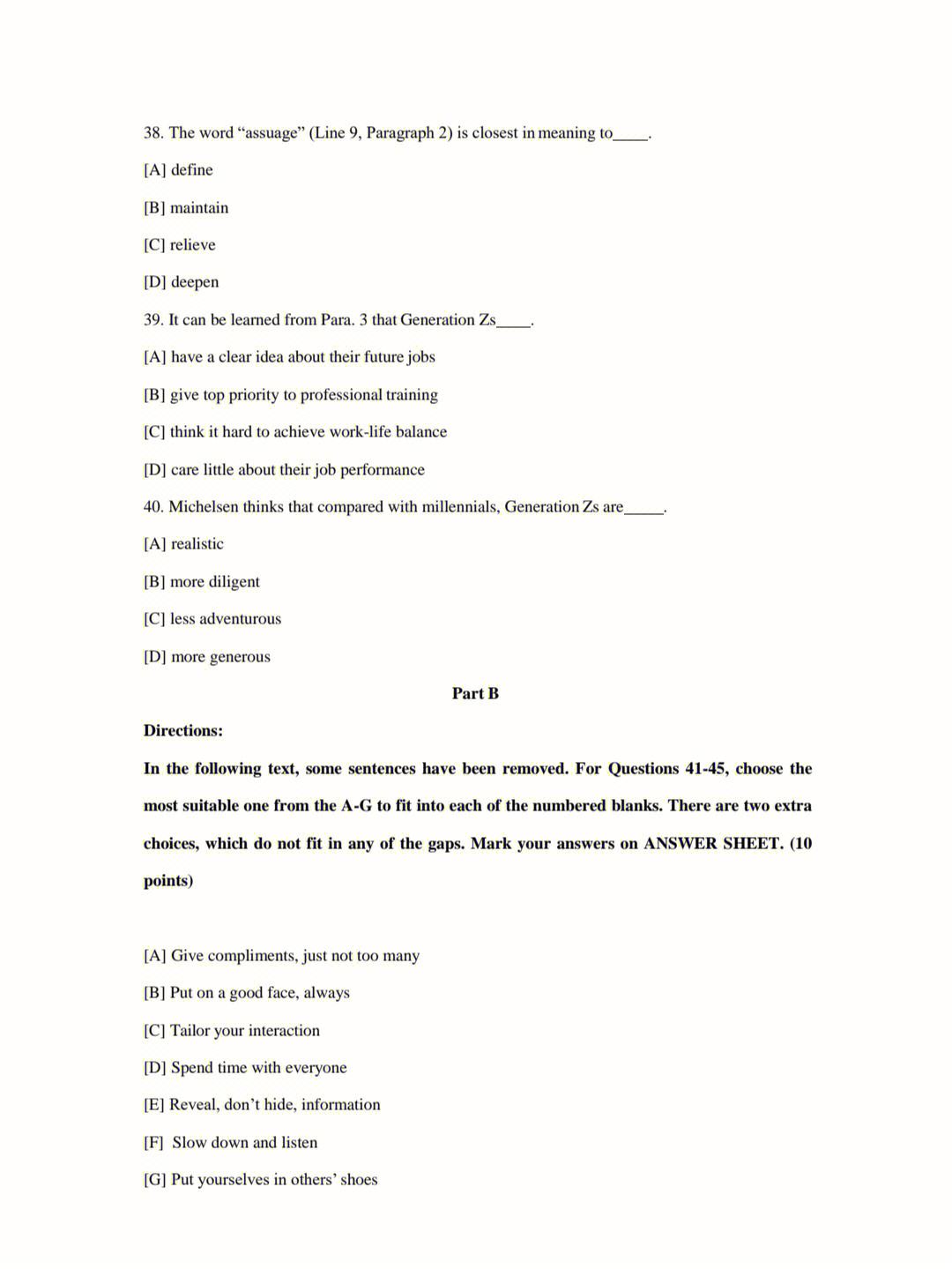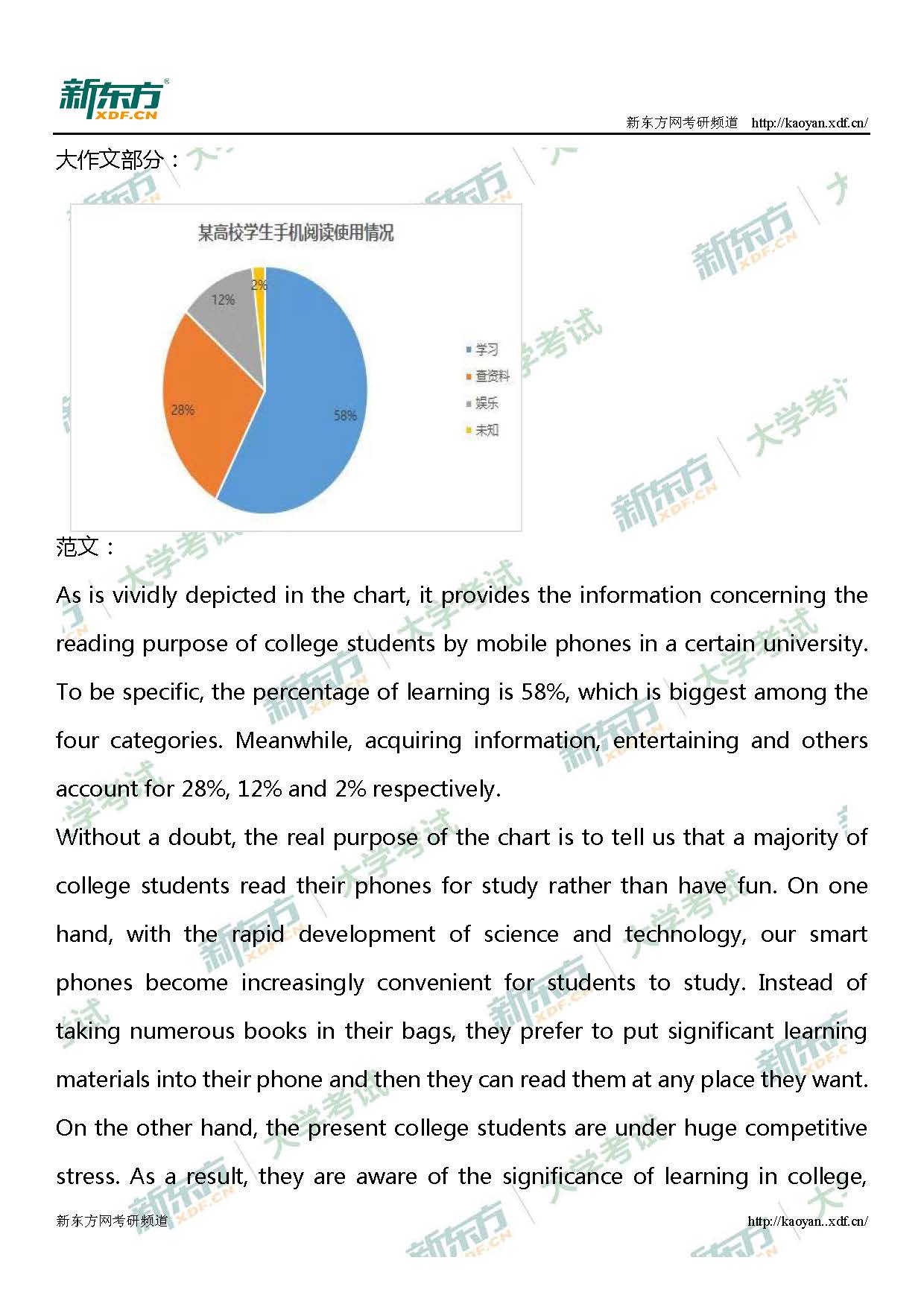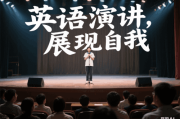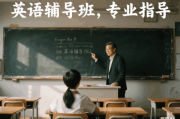
2017年全国硕士学位研究生招生考试初试将于2016年12月24日至25日举行,青年人考研网一如既往的在考后第一时间为考研学子整理发布:2017考研英语(二)真题试题+答案,以帮助大家估分、为后续复试调剂做好准备。更多2017年考研真题及答案解析,请关注微信公众号:【青年人考研网(qnrcnkaoyan)】第一时间获取最新考研资讯!关注青年人考研网微信 第一时间对考研答案 看解析!
2017年硕士研究生考试真题试题及答案解析专题
2017年全国硕士研究生入学统一考试英语(二)
Section I Use of English
Directions:
Read the following text。 Choose the best word (s) for each numbered blank and mark A, B, C or D on the ANSWER SHEET。 (10 points)
People have speculated for centuries about a future without work 。Today is no different, with academics, writers, and activists once again 1 that technology be replacing human workers。 Some imagine that the coming work-free world will be defined by 2 。 A few wealthy people will own all the capital, and the masses will struggle in an impoverished wasteland。
A different and not mutually exclusive 3 holds that the future will be a wasteland of a different sort, one 4 by purposelessness: Without jobs to give their lives 5 , people will simply become lazy and depressed。 6 , today’s unemployed don’t seem to be having a great time。 One Gallup poll found that 20 percent of Americans who have been unemployed for at least a year report having depression, double the rate for 7 Americans。 Also, some research suggests that the 8 for rising rates of mortality, mental-health problems, and addicting 9 poorly-educated middle-aged people is shortage of well-paid jobs。 Perhaps this is why many 10 the agonizing dullness of a jobless future。
But it doesn’t 11 follow from findings like these that a world without work would be filled with unease。 Such visions are based on the 12 of being unemployed in a society built on the concept of employment。 In the 13 of work, a society designed with other ends in mind could 14 strikingly different circumstanced for the future of labor and leisure。 Today, the 15 of work may be a bit overblown。 “Many jobs are boring, degrading, unhealthy, and a waste of human potential,” says John Danaher, a lecturer at the National University of Ireland in Galway。
These days, because leisure time is relatively 16 for most workers, people use their free time to counterbalance the intellectual and emotional 17 of their jobs。 “When I come home from a hard day’s work, I often feel 18 ,” Danaher says, adding, “In a world in which I don’t have to work, I might feel rather different”—perhaps different enough to throw himself 19 a hobby or a passion project with the intensity usually reserved for 20 matters。
1。[A] boasting [B] denying [C] warning [D] ensuring
2。[A] inequality [B] instability [C] unreliability [D] uncertainty
3。[A] policy [B]guideline [C] resolution [D] prediction
4。[A] characterized [B]divided [C] balanced [D]measured
5。[A] wisdom [B] meaning [C] glory [D] freedom
6。[A] Instead [B] Indeed [C] Thus [D] Nevertheless
7。[A] rich [B] urban [C]working [D] educated
8。[A] explanation [B] requirement [C] compensation [D] substitute
9。[A] under [B] beyond [C] alongside [D] among
10。[A] leave behind [B] make up [C] worry about [D] set aside
11。[A] statistically [B] occasionally [C] necessarily [D] economically
12。[A] chances [B] downsides [C] benefits [D] principles
13。[A] absence [B] height [C] face [D] course
14。[A] disturb [B] restore [C] exclude [D] yield
15。[A] model [B] practice [C] virtue [D] hardship
16。[A] tricky [B] lengthy [C] mysterious [D] scarce
17。[A] demands [B] standards [C] qualities [D] threats
18。[A] ignored [B] tired [C] confused [D] starved
19。[A] off [B] against [C] behind [D] into
20。[A] technological [B] professional [C] educational [D] interpersonal
Section II Reading Comprehension
Part A
Directions:
Read the following four texts。 Answer the questions below each text by choosing A, B, C or D。 Mark your answers on the ANSWER SHEET。 (40 points)
Text 1
Every Saturday morning, at 9 am, more than 50,000 runners set off to run 5km around their local park。 The Parkrun phenomenon began with a dozen friends and has inspired 400 events in the UK and more abroad。 Events are free, staffed by thousands of volunteers。 Runners range from four years old to grandparents; their times range from Andrew Baddeley’s world record 13 minutes 48 seconds up to an hour。
Parkrun is succeeding where London’s Olympic “legacy” is failing。 Ten years ago on Monday, it was announced that the Games of the 30th Olympiad would be in London。 Planning documents pledged that the great legacy of the Games would be to level a nation of sport lovers away from their couches。 The population would be fitter, healthier and produce more winners。 It has not happened。 The number of adults doing weekly sport did rise, by nearly 2 million in the run—up to 2012—but the general population was growing faster。 Worse, the numbers are now falling at an accelerating rate。 The opposition claims primary school pupils doing at least two hours of sport a week have nearly halved。 Obesity has risen among adults and children。 Official retrospections continue as to why London 2012 failed to “inspire a generation。” The success of Parkrun offers answers。
Parkun is not a race but a time trial: Your only competitor is the clock。 The ethos welcomes anybody。 There is as much joy over a puffed-out first-timer being clapped over the line as there is about top talent shining。 The Olympic bidders, by contrast, wanted to get more people doing sports and to produce more elite athletes。 The dual aim was mixed up: The stress on success over taking part was intimidating for newcomers。
Indeed, there is something a little absurd in the state getting involved in the planning of such a fundamentally “grassroots”, concept as community sports associations。 If there is a role for government, it should really be getting involved in providing common goods—making sure there is space for playing fields and the money to pave tennis and netball courts, and encouraging the provision of all these activities in schools。 But successive governments have presided over selling green spaces, squeezing money from local authorities and declining attention on sport in education。 Instead of wordy, worthy strategies, future governments need to do more to provide the conditions for sport to thrive。 Or at least not make them worse。
According to Paragraph1, Parkrun has 。
[A] gained great popularity
[B] created many jobs
[C] strengthened community ties
[D] become an official festival
The author believes that London’s Olympic“legacy” has failed to 。
[A] boost population growth
[B] promote sport participation
[C] improve the city’s image
[D] increase sport hours in schools
Parkrun is different from Olympic games in that it 。
[A] aims at discovering talents
[B] focuses on mass competition
[C] does not emphasize elitism
[D] does not attract first-timers
With regard to mass sport, the author holds that governments should 。
[A] organize “grassroots” sports events
[B] supervise local sports associations
[C] increase funds for sports clubs
[D] invest in public sports facilities
The author’s attitude to what UK governments have done for sports is 。
[A] tolerant
[B] critical
[C] uncertain
[D] sympathetic
Text 2
With so much focus on children’s use of screens, it’s easy for parents to forget about their own screen use。 “Tech is designed to really suck on you in,” says Jenny Radesky in her study of digital play, “and digital products are there to promote maximal engagement。 It makes it hard to disengage, and leads to a lot of bleed-over into the family routine。 ”
Radesky has studied the use of mobile phones and tablets at mealtimes by giving mother-child pairs a food-testing exercise。 She found that mothers who sued devices during the exercise started 20 percent fewer verbal and 39 percent fewer nonverbal interactions with their children。 During a separate observation, she saw that phones became a source of tension in the family。 Parents would be looking at their emails while the children would be making excited bids for their attention。
Infants are wired to look at parents’ faces to try to understand their world, and if those faces are blank and unresponsive—as they often are when absorbed in a device—it can be extremely disconcerting foe the children。 Radesky cites the “still face experiment” devised by developmental psychologist Ed Tronick in the 1970s。 In it, a mother is asked to interact with her child in a normal way before putting on a blank expression and not giving them any visual social feedback; The child becomes increasingly distressed as she tries to capture her mother’s attention。 “Parents don’t have to be exquisitely parents at all times, but there needs to be a balance and parents need to be responsive and sensitive to a child’s verbal or nonverbal expressions of an emotional need,” says Radesky。
On the other hand, Tronick himself is concerned that the worries about kids’ use of screens are born out of an “oppressive ideology that demands that parents should always be interacting” with their children: “It’s based on a somewhat fantasized, very white, very upper-middle-class ideology that says if you’re failing to expose your child to 30,000 words you are neglecting them。” Tronick believes that just because a child isn’t learning from the screen doesn’t mean there’s no value to it—particularly if it gives parents time to have a shower, do housework or simply have a break from their child。 Parents, he says, can get a lot out of using their devices to speak to a friend or get some work out of the way。 This can make them feel happier, which lets then be more available to their child the rest of the time。
According to Jenny Radesky, digital products are designed to ______。
[A] simplify routine matters
[B] absorb user attention
[C] better interpersonal relations
[D] increase work efficiency
Radesky’s food-testing exercise shows that mothers’ use of devices ______。
[A] takes away babies’ appetite
[B] distracts children’s attention
[C] slows down babies’ verbal development
[D] reduces mother-child communication
Radesky’s cites the “still face experiment” to show that _______。
[A] it is easy for children to get used to blank expressions
[B] verbal expressions are unnecessary for emotional exchange
[C] children are insensitive to changes in their parents’ mood
[D] parents need to respond to children’s emotional needs
The oppressive ideology mentioned by Tronick requires parents to_______。
[A] protect kids from exposure to wild fantasies
[B] teach their kids at least 30,000 words a year
[C] ensure constant interaction with their children
[D] remain concerned about kid’s use of screens
According to Tronick, kid’s use of screens may_______。
[A] give their parents some free time

[B] make their parents more creative
[C] help them with their homework
[D] help them become more attentive
Text 3
Today, widespread social pressure to immediately go to college in conjunction with increasingly high expectations in a fast-moving world often causes students to completely overlook the possibility of taking a gap year。 After all, if everyone you know is going to college in the fall, it seems silly to stay back a year, doesn’t it? And after going to school for 12 years, it doesn’t feel natural to spend a year doing something that isn’t academic。
But while this may be true, it’s not a good enough reason to condemn gap years。 There’s always a constant fear of falling behind everyone else on the socially perpetuated “race to the finish line,” whether that be toward graduate school, medical school or lucrative career。 But despite common misconceptions, a gap year does not hinder the success of academic pursuits—in fact, it probably enhances it。
Studies from the United States and Australia show that students who take a gap year are generally better prepared for and perform better in college than those who do not。 Rather than pulling students back, a gap year pushes them ahead by preparing them for independence, new responsibilities and environmental changes—all things that first-year students often struggle with the most。 Gap year experiences can lessen the blow when it comes to adjusting to college and being thrown into a brand new environment, making it easier to focus on academics and activities rather than acclimation blunders。

If you’re not convinced of the inherent value in taking a year off to explore interests, then consider its financial impact on future academic choices。 According to the National Center for Education Statistics, nearly 80 percent of college students end up changing their majors at least once。 This isn’t surprising, considering the basic mandatory high school curriculum leaves students with a poor understanding of themselves listing one major on their college applications, but switching to another after taking college classes。 It’s not necessarily a bad thing, but depending on the school, it can be costly to make up credits after switching too late in the game。 At Boston College, for example, you would have to complete an extra year were you to switch to the nursing school from another department。 Taking a gap year to figure things out initially can help prevent stress and save money later on。
One of the reasons for high-school graduates not taking a gap year is that 。
[A] they think it academically misleading
[B] they have a lot of fun to expect in college
[C] it feels strange to do differently from others
[D] it seems worthless to take off-campus courses
Studies from the US and Australia imply that taking a gap year helps 。
[A] keep students from being unrealistic
[B] lower risks in choosing careers
[C] ease freshmen’s financial burdens
[D] relieve freshmen of pressures
The word “acclimation” (Line 8, Para。 3) is closest in meaning to 。
[A] adaptation
[B] application
[C] motivation
[D] competition
A gap year may save money for students by helping them 。
[A] avoid academic failures
[B] establish long-term goals
[C] switch to another college
[D] decide on the right major
The most suitable title for this text would be 。
[A] In Favor of the Gap Year
[B] The ABCs of the Gap Year
[C] The Gap Year Comes Back
[D] The Gap Year: A Dilemma
Text 4
Though often viewed as a problem for western states, the growing frequency of wildfires is a national concern because of its impact on federal tax dollars, says Professor Max Moritz, a specialist in fire ecology and management。
In 2015, the US Forest Service for the first time spent more than half of its $5.5 billion annual budget fighting fires—nearly double the percentage it spent on such efforts 20 years ago。 In effect, fewer federal funds today are going towards the agency’s other work—such as forest conservation, watershed and cultural resources management, and infrastructure upkeep—that affect the lives of all Americans。
Another nationwide concern is whether public funds from other agencies are going into construction in fire-prone districts。 As Moritz puts it, how often are federal dollars building homes that are likely to be lost to a wildfire?
“It’s already a huge problem from a public expenditure perspective for the whole country,” he says。” We need to take a magnifying glass to that。 Like, “Wait a minute, is this OK?” “Do we want instead to redirect those funds to concentrate on lower-hazard parts of the landscape?”
Such a view would require a corresponding shift in the way US society today views fire, researchers say。
For one thing, conversations about wildfires need to be more inclusive。 Over the past decade, the focus has been on climate change—how the warming of the Earth from greenhouse gases is leading to conditions that worsen fires。
While climate is a key element, Moritz says, it shouldn’t come at the expense of the rest of the equation。
“The human systems and the landscapes we live on are linked, and the interactions go both ways,” he says。 Failing to recognize that, he notes, leads to “an overly simplified view of what the solutions might be。 Our perception of the problem and of what the solution is becomes very limited。”
At the same time, people continue to treat fire as an event that needs to be wholly controlled and unleashed only out of necessity, says Professor Balch at the University of Colorado。 But acknowledging fire’s inevitable presence in human life is an attitude crucial to developing the laws, policies, and practices that make it as safe as possible, she says。
“We’ve disconnected ourselves from living with fire,” Balch says。 “It is really important to understand and try and tease out what is the human connection with fire today。”
More frequent wildfires have become a national concern because in 2015 they 。
[A] exhausted unprecedented management efforts
[B] consumed a record-high percentage of budget
[C] severely damaged the ecology of western states
[D] caused a huge rise of infrastructure expenditure
Moritz calls for the use of “a magnifying glass” to 。
[A] raise more funds for fire-prone areas
[B] avoid the redirection of federal money
[C] find wildfire-free parts of the landscape
[D] guarantee safer spending of public funds
While admitting that climate is a key element, Moritz notes that 。
[A] public debates have not settled yet
[B] fire-fighting conditions are improving
[C] other factors should not be overlooked
[D] a shift in the view of fire has taken place
The overly simplified view Moritz mentions is a result of failing to 。
[A] discover the fundamental makeup of nature
[B] explore the mechanism of the human systems
[C] maximize the role of landscape in human life
[D] understand the interrelations of man and nature
Professor Balch points out that fire is something man should 。
[A] do away with
[B] come to terms with
[C] pay a price for
[D] keep away from
Part B
Directions:
Read the following text and match each of the numbered items in the left column to its corresponding information in the right column。 There are two extra choices in the right column。 Mark your answers on the ANSWER SHEET。 (10 points)
The decline in American manufacturing is a common refrain, particularly from Donald Trump。 “We don’t make anything anymore,” he told Fox News, while defending his own made-in-Mexico clothing line。
Without question, manufacturing has taken a significant hit during recent decades, and further trade deals raise questions about whether new shocks could hit manufacturing。
But there is also a different way to look at the data。
Across the country, factory owners are now grappling with a new challenge: instead of having too many workers, they may end up with too few。 Despite trade competition and outsourcing, American manufacturing still needs to replace tens of thousands of retiring boomers every years。 Millennials may not be that interested in taking their place, other industries are recruiting them with similar or better pay。
For factory owners, it all adds up to stiff competition for workers—and upward pressure on wages。 “They’re harder to find and they have job offers,” says Jay Dunwell, president of Wolverine Coil Spring, a family-owned firm, “They may be coming [into the workforce], but they’ve been plucked by other industries that are also doing an well as manufacturing,” Mr。 Dunwell has begun bringing high school juniors to the factory so they can get exposed to its culture。
At RoMan Manufacturing, a maker of electrical transformers and welding equipment that his father cofounded in 1980, Robert Roth keep a close eye on the age of his nearly 200 workers, five are retiring this year。 Mr。 Roth has three community-college students enrolled in a work-placement program, with a starting wage of $13 an hour that rises to $17 after two years。
At a worktable inside the transformer plant, young Jason Stenquist looks flustered by the copper coils he’s trying to assemble and the arrival of two visitors。 It’s his first week on the job。 Asked about his choice of career, he says at high school he considered medical school before switching to electrical engineering。 “I love working with tools。 I love creating。” he says。
But to win over these young workers, manufacturers have to clear another major hurdle: parents, who lived through the worst US economic downturn since the Great Depression, telling them to avoid the factory。 Millennials “remember their father and mother both were laid off。 They blame it on the manufacturing recession,” says Birgit Klohs, chief executive of The Right Place, a business development agency for western Michigan。
These concerns aren’t misplaced: Employment in manufacturing has fallen from 17 million in 1970 to 12 million in 2013。 When the recovery began, worker shortages first appeared in the high-skilled trades。 Now shortages are appearing at the mid-skill levels。
“The gap is between the jobs that take to skills and those that require a lot of skill,” says Rob Spohr, a business professor at Montcalm Community College。 “There’re enough people to fill the jobs at McDonalds and other places where you don’t need to have much skill。 It’s that gap in between, and that’s where the problem is。 ”
Julie Parks of Grand Rapids Community points to another key to luring Millennials into manufacturing: a work/life balance。 While their parents were content to work long hours, young people value flexibility。 “Overtime is not attractive to this generation。 They really want to live their lives,” she says。
[A] says that he switched to electrical engineering because he loves working with tools。
41。 Jay Deuwell[B] points out that there are enough people to fill the jobs that don’t need much skill。
42。 Jason Stenquist[C] points out that the US doesn’t manufacture anything anymore。
43。 Birgit Klohs[D] believes that it is important to keep a close eye on the age of his workers。
44。 Rob Spohr[E] says that for factory owners, workers are harder to find because of stiff competition。
45.Julie Parks[F] points out that a work/life balance can attract young people into manufacturing。
[G] says that the manufacturing recession is to blame for the lay-off the young people’s parents。
2017年考研英语二范文
新东方在线&北京新东方 李智勇
2017年考研进行得如火如荼,此次英语二考的大作文是曲线图,虽然以往没有考过这类型的图表,但是难度并不大。
这种图形写作与2010、2011所考的柱状图写法有很大相似之处,都是有关一定时间段内数量变化的类型,可以说是换汤不换药。该图表涉及内容是参观博物馆的人数变化数据,关键词也不难写,故此从难度上看,属于中低难度。
图中的关键词,博物馆(museum)是中学词汇,有基础能力的同学可以相对轻松把握;博物馆参观者用简单的visitors即可;至于图表中的数字是十万,6378个十万即6.378 billion.
范文如下:
The statistics about museums and their visitors are precisely illustrated by the line chart. During the 3 years from 2013 to 2015, the figure of museums experienced a gradual rise, and soaring from 4.145 thousand to 4.692 thousand. Besides, following the same tendency, the number of museum visitors, as is shown, ascended gradually from 6.378 billion to 7.811 billion, increasing by about 1.43 billion.
The following factors, from my perspective, are responsible for the statistics. To begin with, aside from disseminating knowledge in schools, department concerned adopts other ways to promote the comprehensive quality of Chinese citizens, for instance providing more access to museums is a simple yet effective way to broaden visitors’ horizon. In addition, having been experiencing the unparalleled material prosperity, most of Chinese citizens intend to pursue knowledge by visiting museums, tourist attractions and other places. Moreover, museums, which are supported by public funding, provide visitors with knowledge and professional service. Individuals, therefore, are inclined to enjoy their leisure time by visiting museums.
To summarize, the data shown by the chart objectively reflect what’s happening in our society. Museums undoubtedly exert indispensible effects on our society and Chinese citizens, and it is predictable that, in the next decade, both large cities and small towns will witness the popularization of museums.
2017年考研英语二,小作文考察的是一封邀请信的回函,要求写作内容包括:
1、接受教授邀请给留学生做有关中国文化的presentation(介绍/演示)。
2、提供介绍内容的关键信息。
考官出题的套路并不好预测,和往年一样,让想依靠背模板来过写作关的同学眼前一黑,这完全证实了考研英语反押题反模板的一贯思路。不过从内容上看,写作手法也秉承了以往考研英语二小作文的思路----多种文体结合。
此次写作完全可以写成一个感谢开头结合内容介绍的格式,思路简单但操作略有难度。写作过程中最难的地方在于有关中国文化的关键信息,对考生的基本功有一定要求。
小作文
Dear Professor Williams,
It is my honor to receive your invitation to give presentation about Chinese culture to international students. And I am writing to express my heartfelt gratitude and provide the specific information about my presentation, which is about the brief introduction of Confucianism, the dominant philosophy of oriental culture.
To begin with, the first part of my presentation is the brief introduction to Master Confucius and the Analects of Confucius. Relevant background about Spring and Autumn warring state period will also be introduced. In addition, the second part is about etiquette, one of the cores of Confucianism, which stabilized ancient Chinese society. Moreover, I would like to upload the e-book of English version of the Analects of Confucius to the official website of our university, so that the audience will be fully prepared.
Thank you for your invitation, and I wish my presentation will be appreciated by the audience.
Yours sincerely,
Li Ming
亲爱的威廉教授:
很荣幸收到您邀请我给留学生做关于中国文化的介绍,我在此对您表达衷心的谢意并提供相关的具体信息。我的介绍是关于东方文化的主导哲学思想儒家的内容。
首先,我介绍的第一部分是关于孔子和《论语》的简介。同时还会介绍有关春秋战国的背景。其次,我的第二部分是关于“礼”的介绍。作为儒家思想的核心之一,“礼”为古代中国社会具有了稳定性。再次,我会把这些作品的电子版上传到我们大学的官方网站,以便听众能方便的下载,并对我的讲授内容做出充分准备。
感谢您对我的邀请,我希望我的介绍能被大家欣赏。
李明
2017年考研英语(二)真题答案
想了解更多考研相关的信息,请关注微信公众号:青年人考研网(qnrcnkaoyan)
相关推荐:
2017年考研英语(一)试题+答案
2017年考研政治真题及答案(完整版)
2017年考研管理类联考真题试题原文及答案
标签: #考研英语二真题及答案








